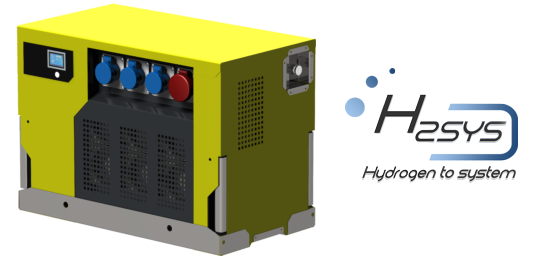
The hydrogen generator “Boxhy” invites itself in the vehicles of firefighters
On the occasion of the launch of Magirus’ new Innovative Drive Line vehicle, a fire engine with electric propulsion and natural gas, a fuel cell electric generator was installed onboard the vehicle to supply all electrical equipment used during an intervention.
Boxhy – a hydrogen generator set designed specifically for firefighters
 In 2016, Alpina Technologie GmbH – specializing in the distribution of innovative equipment for firefighters and rescue forces in Germany – asked H2SYS to develop a hydrogen generator for the German market.
In 2016, Alpina Technologie GmbH – specializing in the distribution of innovative equipment for firefighters and rescue forces in Germany – asked H2SYS to develop a hydrogen generator for the German market.
After 2 years of research, mechanical integration and development around DIN 14685, specific to generators for the fight against fire, H2SYS launched in 2019 the Boxhy generator: a portable hydrogen generator set dedicated to events and electrical needs off-grid.
Available in a specific version for the firefighters market, Boxhy integrates a 3.5 kW fuel cell and addresses the issue of noise and gaseous pollutants during operations.
Deployed in Germany by Alpina Technologies, the generators have been designed around two strong axes: comfort of use and safety.
Hydrogen: simplicity and security
The generator starts instantly thanks to built-in batteries, which are also used to manage power calls.
They are driven by a program that also oversees the operation of the hydrogen fuel cell: it continuously calculates the best way to deliver the required energy by reducing hydrogen consumption.
Side interfaces, the various jacks on the front can connect multiple tools simultaneously such as pumps, lighting mats or communication devices.
The side handles of handling are very convenient to load or move the machine.
Completely silent, only the noise of the fans supplying oxygen to the fuel cell attests to the operation of the device.
To recharge it, one must simply plan to replace the hydrogen bottles, and integrated tank solutions will soon be filling directly in the stations.
In terms of security, the use of hydrogen in constraining environments requires the implementation of specific protections:
Safety devices, such as hydrogen sensors and pressure and temperature controls, automatically initiate closing of the gas solenoid valves in the event of a malfunction.
Source: H2Sys
Read the most up to date Fuel Cell and Hydrogen Industry news at FuelCellsWorks




